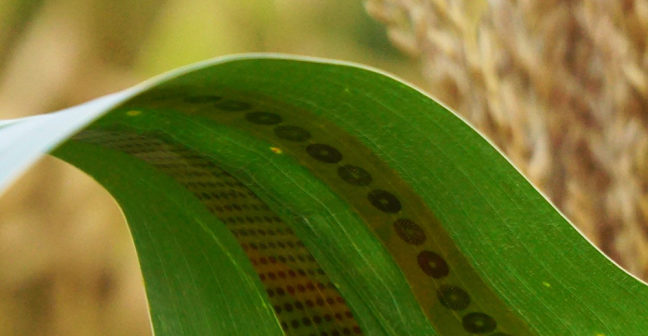Researchers at Iowa State University have developed a new, low-cost, easily produced, graphene-based, sensors-on-tape that can be attached to plants and can provide new kinds of data to researchers and farmers. “With a tool like this, we can begin to breed plants that are more efficient in using water,” said Patrick Schnable, a plant scientist at the university. “That’s exciting. We couldn’t do this before. But, once we can measure something, we can begin to understand it.”
The tool making these water measurements possible is a tiny graphene sensor that can be taped to plants – researchers have dubbed it a “plant tattoo sensor.” Graphene is a wonder material. It’s a carbon honeycomb just an atom thick, it’s great at conducting electricity and heat, and it’s strong and stable. The graphene-on-tape technology in this study has also been used to produce wearable strain and pressure sensors, including sensors built into a “smart glove” that measures hand movements. Researchers describe the various sensors and the “simple and versatile method for patterning and transferring graphene-based nanomaterials” to create the flexible sensors in a paper featured on the cover of the December 2017 issue of the journal Advanced Materials Technologies. The research has been primarily supported by the Faculty Scholars Program of Iowa State’s Plant Sciences Institute. Liang Dong, an Iowa State associate professor of electrical and computer engineering, is the lead author of the paper and developer of the technology. Seval Oren, a doctoral student in electrical and computer engineering, is a co-author who helped develop the sensor-fabrication technology.
Co-authors who helped test applications of the sensors are Schnable, director of Iowa State’s Plant Sciences Institute, a Charles F. Curtiss Distinguished Professor in Agriculture and Life Sciences, the Iowa Corn Promotion Board Endowed Chair in Genetics and the Baker Scholar of Agricultural Entrepreneurship; and Halil Ceylan, a professor of civil, construction and environmental engineering. “We’re trying to make sensors that are cheaper and still high performing,” Dong said. To do that, the researchers have developed a process for fabricating intricate graphene patterns on tape. Dong said the first step is creating indented patterns on the surface of a polymer block, either with a molding process or with 3-D printing. Engineers apply a liquid graphene solution to the block, filling the indented patterns. They use tape to remove the excess graphene. Then they take another strip of tape to pull away the graphene patterns, creating a sensor on the tape. The process can produce precise patterns as small as 5 millionths of a meter wide – just a twentieth of the diameter of the average human hair. Dong said making the patterns so small increases the sensitivity of the sensors.




